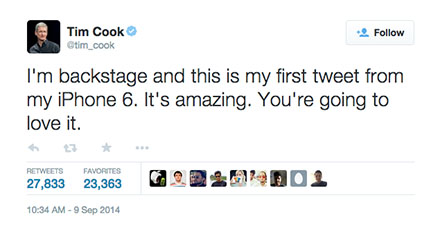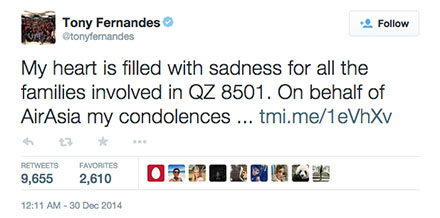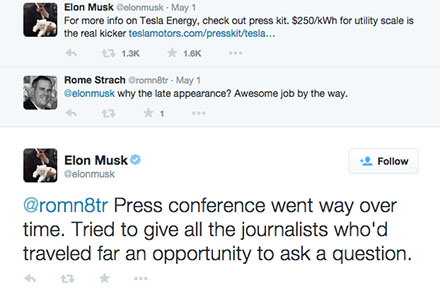Breaking barriers: 7 ways CEOs use Twitter to build better brands
People trust people, and this isn’t just a vapid saying. That’s why companies now are warming up to social media engagement, which facilitates humanization and helps brands put a voice, maybe even a face, to the company. A study by Weber Shandwick confirms it: About two-thirds of customers say their perception of a CEO directly impacts their perception of the company. Executives on social media appear more open, accessible, and inspirational than those who don’t. So then why aren’t more strategists getting executives involved?
Despite the potential advantages, social media can be time consuming and risky for an executive. But the benefits — staying ahead of the curve, getting an edge on the competition, and gaining trust, to name a few — outweigh the obstacles. Twitter is a fairly innocuous way for CEOs to get their social-media feet wet. It’s intuitive to use, and allows executives to participate simultaneously in global conversations and one-on-one dialogue. The key is for CEOs to build their personal brands in an authentic way.
That’s why we’ve put together seven ways executives can use Twitter to share compelling content from their personal and professional lives and connect with the public.
1. Show genuine excitement about a product’s launch.
On September 9, 2014, Apple CEO Tim Cook tweeted a simple message that would easily catch the attention of 27,000 people:
 As part of the iPhone 6 reveal, this tweet marked the first true introduction of the product. It was done simply and modestly — the message engaged its audience on a personal level and didn’t come off as a promotion. The magic of the medium is that it ignites excitement in a natural, down-to-earth way, like a conversation between two old friends. Who wants to feel like the “target audience” of a cold corporation? Using Twitter to connect with customers and prospects is so easy that it doesn’t make sense not to do it, especially when it comes to promoting your products. True, Apple’s products are so wildly popular that they almost sell themselves, but all companies can benefit from an executive who shares an unbridled enthusiasm for his or her own products.
As part of the iPhone 6 reveal, this tweet marked the first true introduction of the product. It was done simply and modestly — the message engaged its audience on a personal level and didn’t come off as a promotion. The magic of the medium is that it ignites excitement in a natural, down-to-earth way, like a conversation between two old friends. Who wants to feel like the “target audience” of a cold corporation? Using Twitter to connect with customers and prospects is so easy that it doesn’t make sense not to do it, especially when it comes to promoting your products. True, Apple’s products are so wildly popular that they almost sell themselves, but all companies can benefit from an executive who shares an unbridled enthusiasm for his or her own products.
2. Expand the reach of thought leadership.
What exactly is a thought leader? It’s someone who moves and inspires others with innovative ideas, transforms ideas into reality, and gains a dedicated following to help them create real change. Executives seeking to increase awareness of their thought leadership can use Twitter to expand the reach of their ideas.
Tangerine Bank CEO Peter Aceto demonstrates how his commitment to open dialogue makes him and his company different from any other financial services corporation out there. Aceto maintains hands-on access to his own account and regularly engages with followers by sharing information and links he finds interesting. He avoids self-promotion and rarely tweets about the bank, opting instead to share information that he finds valuable as a business leader — a real thought leader who becomes a resource for others seeking to improve their own skills.
3. Be human and send your brand’s profile through the roof.
Research shows that executives who use social media to help raise their brand’s profile instill confidence in their company’s team, build more trust, and create brand loyalty among their customers.
Take Virgin Group founder Richard Branson, for example. Recognized for his social media presence by LinkedIn, Branson uses it to communicate with the public and improve business, not just to promote Virgin. He speaks in his own voice, pays attention to feedback, pushes a global perspective, and is incredibly generous in sharing his life and behind-the-scenes views of his company with his customers. We often look to the boss as the face of the company, and Branson completely owns this role. And his successful personal brand is a powerful reflection of his company’s success.
4. Put out the fires of crises.
Social media is a tricky thing indeed. It can hurt a reputation but it can also save one. With great finesse, CEOs can take to Twitter during moments of crisis in order to inform, respond to, and even reassure the public.
Following the crash of an AirAsia plane on December 28, 2014, GCEO Tony Fernandes didn’t fall digitally silent. Instead, he updated followers on recovery efforts, expressed concern about victims’ families, and boosted staff morale. Twitter is a great way to disseminate information and show compassion to a large number of people quickly. The platform is also a useful way to catch wind of customer concerns immediately and respond effectively.

5. Enlighten the public and change the world, one tweet at a time.
There is tremendous benefit for nonprofit organizations and foundations when an executive does Twitter right. Visit Bill Gates’s Twitter profile and you’ll find over 22 million followers, as of May 2015, enraptured by the Microsoft CEO’s feed.
Gates uses the platform to encourage others to support his charity and causes related to energy innovation, education, and global health, such as AIDS and malaria. His social media presence helps attract thousands to charities, plays a useful role in internal communications, and creates a positive impression on his various initiatives.
6. Reach out to other entrepreneurs.
Sharing industry news and content can help build an entrepreneurial audience, improve authority, and attract more business partnerships. There is a high-level entrepreneurial energy that can be tapped into on Twitter, and it’s easy to network and create a community of business leaders as a result.
Known to many as a dotcom hero, Brent Hoberman has played a part in spearheading many successful Internet businesses such as lastminute.com. Today, he puts energy into creating initiatives and events that foster leading entrepreneurs and CEOs on the rise. Executives such as Hoberman use Twitter to set up experiences and events where business leaders can meet and swap ideas.
7. Engage one-on-one with journalists.
In today’s hyper-connected, information-driven world, Twitter is the modern PR outlet that gives executives the chance to build engagement and trust among customers, employees, and investors. It can also be a great tool for building relationships with reporters and getting your stories out there. As of June 2013, 60% of journalists worldwide used Twitter, with over half of all journalists citing Twitter as a source for gathering story ideas.
Tesla CEO Elon Musk rocks at forging positive relationships with the press via Twitter. Not only does he use the platform to share news and promote Tesla in creative ways, but he also does a great job connecting with the press by tweeting press kits, touching base on press conferences, and engaging in one-on-one conversations with journalists.

With these tips in mind, you can start planning a social media strategy that is authentic and effective, for yourself or your senior executive. If you’re not convinced, what’s holding you back? Let us know in the Comments section.